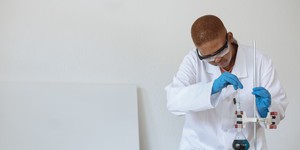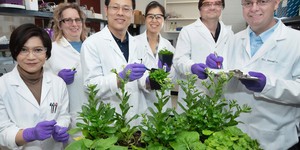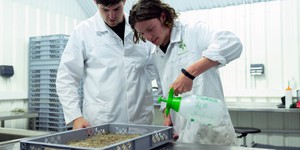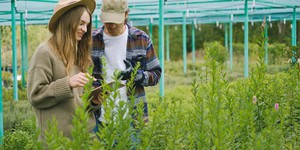Abstract
You have most likely witnessed the change that occurs as a banana ripens It changes from green and relatively hard to yellow and soft. The flavor also changes, from bitter to sweet. What happens during ripening? One big change is the increase in sugar content. In this food science fair project, you will measure how the sugar content of a banana changes as it ripens.Summary
David B. Whyte, PhD, Science Buddies
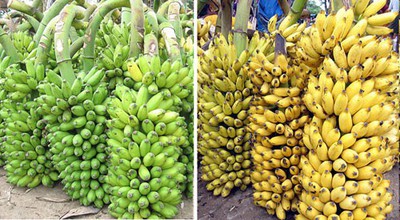
Objective
Use a refractometer to measure sugar content in ripening fruit.Introduction
Ripening is a process in fruits that causes them to become sweeter, softer, and less green. The process of ripening is controlled by the plant hormone called ethylene, which is a gas created by plants from the amino acid called methionine. A plant hormone is a chemical that regulates growth and other processes. Storing fruit in a closed container keeps the ethylene from drifting away and can increase the rate at which the fruit ripens. Ethylene increases the intracellular levels of certain enzymes in fruit. Enzymes are proteins that make certain chemical reactions occur faster than they normally would. The key enzymes involved in fruit ripening are amylase and pectinase. Amylase breaks down starch to produce simple sugars, so is responsible for the increasing sweetness of a ripening fruit. Pectinase breaks down pectin, a substance that keeps fruit hard, so is responsible for the increasing softness of ripening fruit. Other enzymes cause the color of the fruit to change by breaking down chlorophyll (which is green) and replacing it with pigments that are yellow, red, or other colors.

Figure 1. Various stages in the ripening of bananas. The fruit becomes softer and sweeter as it ripens, due to the activity of enzymes, such as pectinase and amylase. (Wikipedia, 2009.)
Measuring the amount of sugar in ripening fruit is a critical step in deciding when to harvest certain kinds of fruit. The sugar content of grapes that are harvested to make wine, for example, is routinely checked during the grapes' development. The instrument used to measure the sugar content is called a refractometer. A refractometer takes advantage of the fact that the higher the amount of sugar dissolved in the juice of a grape, the more the juice will cause a beam of light to bend, or refract. Actually, any dissolved solid will increase the refractive index of a solution. Because the major dissolved solid in fruit juices is sugar, the refractometer reading is a measure of dissolved sugar.
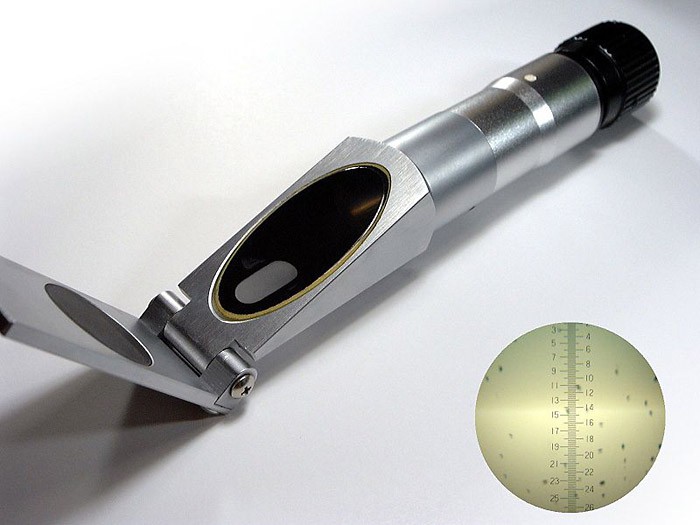 Image Credit: Wikipedia / Wikipedia Commons
Image Credit: Wikipedia / Wikipedia Commons
Figure 2. A traditional handheld refractometer. A refractometer is used to measure refractive index. For a solution of sugar, the refractive index can be used to determine the sugar content. (Wikipedia, 2009.)
There is also a special unit to measure the amount of sugar that is dissolved in a solution: degrees Brix. Degrees (°) Brix is a measurement of the dissolved sugar-to-water ratio of a liquid. It is measured with a refractometer. A 15°Brix solution has 15 grams (g) of sugar per 100 g of solution. Or, to put it another way, there are 15 g of sucrose sugar and 85 g of water in the 100 g of solution. Note that degrees Brix depends on the mass of sugar and water, and not on the volume of the solution.
Refractometers are easy to use. A few drops of the liquid are placed on the glass of the refractometer and the cover is closed. You then look through the eyepiece and read the degrees Brix on the scale that is visible inside. The amount of sugar in the solution is determined by where the color changes. Figure 3 shows the reading in a refractometer for a solution that has about 3.2°Brix. In this food science fair project, you will use a refractometer to measure how the sugar content changes in bananas as they ripen. Bananas are a good choice because ripening is accompanied by a clear change in color. This will allow you to select a variety of bananas at various stages of ripeness for testing.
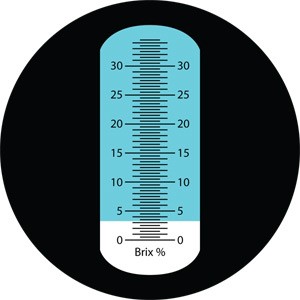 Image Credit: Wikipedia / Wikipedia Commons
Image Credit: Wikipedia / Wikipedia Commons
Figure 3. The degrees Brix can be read from a scale inside the refractometer. Solutions with higher sugar cause more light refraction (bending), which is reflected on the scale. (Wikipedia, 2009.)
Terms and Concepts
- Plant hormone
- Ethylene
- Amino acid
- Methionine
- Enzyme
- Amylase
- Pectinase
- Starch
- Pectin
- Chlorophyll
- Refractometer
- Refract
- Refractive index
- Degrees Brix
Questions
- What is the role of ethylene in fruit ripening?
- What is broken down to make sugar in fruit?
- What enzyme is responsible for making more sugar in fruit?
- Based on your research, what is the principle of operation of a handheld refractometer?
Bibliography
- Hansen, J. University of Puget Sound. (2003). Refractometry. Retrieved September 15, 2009.
- Mueller, S. and Vasquez, S. (n.d.). Refractometer Calibration, Use, and Maintenance. Retrieved September 15, 2009.
- Wikipedia Contributors. (2009, September 18). Handheld refractometer. Retrieved September 18, 2009.
Materials and Equipment
- Bananas, unripe (5 per trial; 3 trials)
- Metal dinner fork and knife
- Dinner plate
- Cheesecloth
- Scissors
- Refractometer, handheld; available at www.amazon.com
- Lab notebook
Disclaimer: Science Buddies participates in affiliate programs with Home Science Tools, Amazon.com, Carolina Biological, and Jameco Electronics. Proceeds from the affiliate programs help support Science Buddies, a 501(c)(3) public charity, and keep our resources free for everyone. Our top priority is student learning. If you have any comments (positive or negative) related to purchases you've made for science projects from recommendations on our site, please let us know. Write to us at scibuddy@sciencebuddies.org.
Experimental Procedure
- To begin, collect five unripe bananas. Choose five bananas that are similar in size and that are all unripe. The bananas should be as similar to each other as possible. The pieces of fruit should be unripe when you take your first reading at the start the procedure and very ripe for the last reading.
- Read the directions that came with your refractometer.
- On the day you purchase them, cut off a section of one of the unripe bananas that is about 3 inches in length.
- Place the banana section on the plate and mash it thoroughly with a fork.
- Cut a 6-inch square of cheesecloth.
- Place about one-third of the chopped banana in the cheesecloth and squeeze out a few drops of juice onto the lens of the refractometer.
- Squeeze slowly so that the juice has time to flow through the cloth. As an alternative, you can wipe the surface of the wet cloth on the glass of the refractometer.
- Read the sugar content of the unripe banana. Record the data in a data table in your lab notebook. Be sure to note the trial number, condition of the fruit, date, and sugar content (in Brix). Discard the fruit in the cheesecloth.
- Repeat steps 4–7 with the remaining freshly mashed banana two more times. Use new cheesecloth and banana for each reading. You should have three separate readings for each piece of fruit.
-
Repeat steps 4–7 for the remaining pieces of fruit, as they ripen, as follows. Note: You might want to modify the days on which you take your Brix readings, depending on how quickly the fruit is ripening.
- Day 2: Test the second piece of fruit.
- Day 4: Test the third piece of fruit.
- Day 6: Test the fourth piece of fruit.
- Day 8: Test the last piece of fruit.
- Perform the entire procedure two more times. This demonstrates that your results are repeatable. The tests can be run concurrently.
- Average the degrees Brix for each day and record these numbers in your lab notebook.
- Graph the time, in days, on the x-axis and the degrees Brix on the y-axis.
Ask an Expert
Global Connections
The United Nations Sustainable Development Goals (UNSDGs) are a blueprint to achieve a better and more sustainable future for all.
Variations
- Store the bananas at different temperatures and compare the rate of ripening.
- Compare the rate of ripening in bananas that are kept in a sealed container to bananas that are exposed to the air. To minimize differences between the two batches, put an equal number of fruit pieces into two identical containers, and then seal one of them. Make sure the temperature, moisture, etc. are the same for the two batches of fruit. You could also compare fruit stored in a closed paper bag to those stored in an open paper bag.
- What happens to the rate at which the fruit ripens if you store it with other fruit, such as with a ripe apple or banana? Also, you could compare bruised bananas vs. un-bruised bananas (bruised fruit produces more ethylene gas).
- Devise a way to determine how sugar content changes as a fruit of your choice ripens on a vine.
Careers
If you like this project, you might enjoy exploring these related careers:


